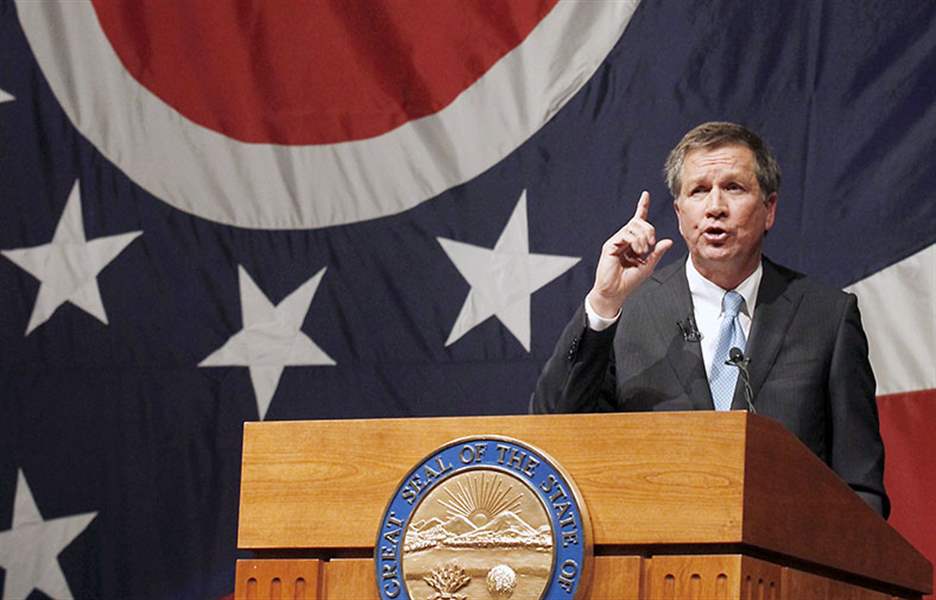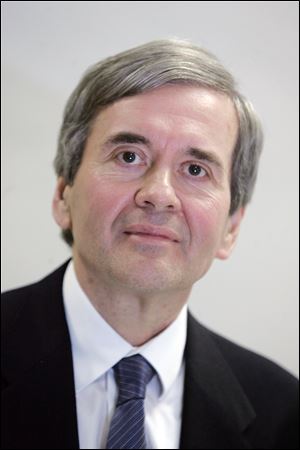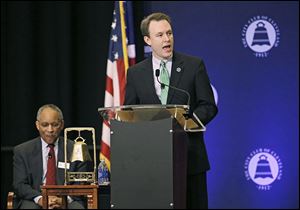
COMMENTARY
Ohio’s campaign for governor needs to get better
By far the biggest state issue on Ohio voters’ minds is jobs and the lack of them
2/23/2014
Gov. John Kasich will deliver his annual State of the State address in Medina Monday night. He made last year’s address in Lima.
THE BLADE
Buy This Image

Kushma
When Gov. John Kasich delivers his State of the State address tomorrow night, you can expect to hear that Ohio is a great place these days, bursting with good new jobs.
The Republican governor’s speech will be the unofficial kickoff of his re-election campaign, an effort to summarize his first term in a way that will encourage Ohioans to give him a second term this November — and perhaps position himself for a presidential run in 2016. For now, our state’s voters may need a lot of persuading.
A poll released last week by Quinnipiac University’s authoritative polling institute gives Governor Kasich just a 5-point lead over his likely Democratic challenger, Cuyahoga County Executive Ed FitzGerald. It isn’t that Mr. FitzGerald is running a textbook campaign: Seven out of 10 Ohio voters who were surveyed said they don’t know enough about him to form an opinion, good or bad.
More troublesome for the governor is the poll’s suggestion that nearly half of Ohioans think he doesn’t care about the needs and problems of people like them. More voters disapprove than approve of the way Mr. Kasich is handling the state’s economy and jobs — a reversal of his poll numbers from last year.

Gov. John Kasich will deliver his annual State of the State address in Medina Monday night. He made last year’s address in Lima.
Governor Kasich “hasn’t made the sale yet for a second term,” Peter Brown, an assistant director of the Quinnipiac institute, told me. “He’s in a horse race with a relatively unknown challenger [whom] people don’t have an opinion of.”
By far the biggest state issue on Ohio voters’ minds, the poll makes clear, is jobs and the lack of them. During his campaign, Mr. Kasich will assert that his tax cuts and business-friendly economic policies have improved the state’s employment climate.
The governor’s detractors note that Ohio’s unemployment rate exceeds the nation’s, and argue that the governor has earned no credit for whatever jobs the state has added during his term. They point to a study last December by the Federal Reserve Bank of Philadelphia that identifies Ohio as one of just four states whose economy is not growing.
Governor Kasich’s first-term record has more-appealing aspects, especially when he has distanced himself from the backward-facing, GOP-controlled General Assembly. Despite his criticism of Obamacare, he has expanded Ohio’s Medicaid program under the Affordable Care Act — a vital step that the legislature resisted and that many Republican governors of other states have refused to take. His Medicaid administrators have worked well to limit health-care costs without weakening quality or access.
Mr. Kasich advocates a higher tax on oil and natural-gas drilling, allowing Ohioans to benefit from the state’s fracking boom, than industry-cowed lawmakers are willing to support. He has abandoned an ill-considered plan to allow drilling in state parks, albeit after a clumsy effort by his administration to promote the bad idea.
The governor’s 51-percent job approval rating among Ohio voters is one that many other politicians “would trade their firstborn for,” Mr. Brown says. Mr. Kasich also gets good marks from voters for judgment and honesty.
Then there’s the other side of the ledger. Mr. Kasich tried to gut the collective-bargaining rights of public employees soon after he took office, until voters vetoed that effort. That’s something Ohio unions have neither forgotten nor forgiven — most of them, anyway: Allied Construction Trades Ohio, a union lobbying group whose members get a lot of work from state contracts, evidently has placed its bet for November by making the maximum contribution it can to the governor’s campaign and stiffing Mr. FitzGerald.

Democratic gubernatorial hopeful and Cuyahoga County Executive Ed FitzGerald delivered his State of the County address in Cleveland last week.
Governor Kasich has presided over big reductions in state aid to public schools and local governments — some of them induced by the Great Recession — while advocating tax cuts that have benefited the wealthiest Ohioans ahead of middle-class and lower-income taxpayers. He has unnecessarily enforced work rules that have cost thousands of Ohioans needed food-stamp benefits, at a time when they have few job prospects.
The governor has worked to restrict Ohio women’s reproductive rights. He has placed the state’s economic development efforts behind a wall of secrecy. He has taken part in gerrymandering and vote-suppression schemes that have undemocratically rigged our state’s legislature and U.S. House delegation in favor of his party.
That record offers ample opportunity for an aggressive, effective challenge. But Mr. Fitzgerald, who faces what appears to be nuisance opposition in the May 6 Democratic primary, hasn’t conducted that campaign yet.
Although Mr. Fitzgerald has been running for governor since last April, the Quinnipiac poll suggests that more than two-thirds of Ohio voters still couldn’t pick him out of a lineup. That raises questions, Mr. Brown says, “about his ability to make Joe and Jill Buckeye want to put the state in his hands.”
Mr. FitzGerald is at a 5-to-1 fund-raising disadvantage to Mr. Kasich. “The candidate with the most money doesn’t always win,” Mr. Brown notes, “but more often than not, does. Wait until you start seeing all the [TV] ads” from the governor’s campaign, he adds.
And when Mr. FitzGerald’s campaign has attracted attention, it’s often been for the wrong reasons. His first choice of a running mate for lieutenant governor, since dumped, turned out to have run up an $826,000 delinquent tax bill.
More recently, Mr. FitzGerald demanded that Governor Kasich pledge that he will complete his term if he is re-elected before campaigning for another office. Observers promptly noted that the Democratic candidate has not applied such a standard to himself.
New Jersey Gov. Chris Christie’s traffic problems have revived talk of a White House bid for Mr. Kasich in two years. He might not want to quit his day job just yet: According to the Quinnipiac poll, if the election were held today, Ohio voters would prefer Democrat Hillary Clinton over their favorite son by a 51-39 margin. (Ohioans also favor Ms. Clinton over every other Republican named in the poll.)
But Mr. Kasich needs to get through this year’s election first. Ohio voters likely will have a clear ideological choice when we elect a governor in November. Let’s hope we also get a meaningful campaign before that.
David Kushma is editor of The Blade.
Contact him at: dkushma@theblade.com or on Twitter @dkushma1